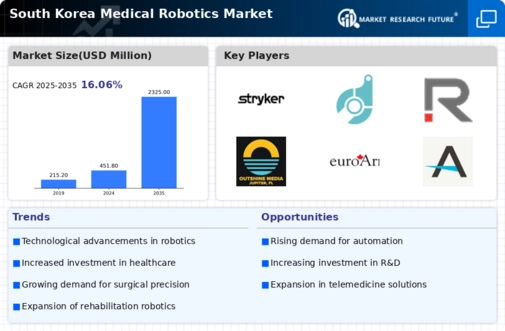The medical robotics market in South Korea is characterized by a dynamic competitive landscape, driven by technological advancements and increasing demand for minimally invasive surgical procedures. Key players such as Intuitive Surgical (US), Medtronic (US), and Siemens Healthineers (DE) are at the forefront, leveraging innovation and strategic partnerships to enhance their market positions. Intuitive Surgical (US) continues to dominate with its da Vinci surgical system, focusing on expanding its product offerings and enhancing user experience through software upgrades. Meanwhile, Medtronic (US) emphasizes its commitment to integrating robotics with its existing surgical solutions, aiming to provide comprehensive surgical platforms that improve patient outcomes. Siemens Healthineers (DE) is also making strides by investing in AI-driven robotics, which suggests a shift towards more intelligent surgical systems that can adapt to various clinical scenarios.
In terms of business tactics, companies are increasingly localizing manufacturing and optimizing supply chains to enhance operational efficiency. The market appears moderately fragmented, with several players vying for market share, yet the influence of major companies remains substantial. This competitive structure allows for innovation to flourish, as smaller firms often collaborate with larger entities to bring new technologies to market.
In October 2025, Intuitive Surgical (US) announced a partnership with a leading South Korean hospital to develop advanced training programs for surgeons using its robotic systems. This initiative not only enhances the skill set of local surgeons but also solidifies Intuitive's presence in the region, potentially increasing its market share. The strategic importance of this partnership lies in its ability to foster trust and familiarity with the technology among healthcare professionals, which could lead to increased adoption rates.
In September 2025, Medtronic (US) launched a new robotic-assisted surgical platform tailored for orthopedic procedures, specifically designed to cater to the South Korean market. This launch is significant as it addresses the growing demand for orthopedic surgeries in the region, positioning Medtronic as a key player in this niche. The platform's advanced features, including real-time imaging and analytics, may enhance surgical precision and patient outcomes, thereby reinforcing Medtronic's competitive edge.
In August 2025, Siemens Healthineers (DE) unveiled a new AI-driven robotic system aimed at improving surgical workflows in hospitals. This development is particularly noteworthy as it reflects the increasing trend towards digitalization in healthcare. By integrating AI capabilities, Siemens Healthineers (DE) is likely to enhance operational efficiencies and reduce surgical times, which could be a game-changer in the competitive landscape.
As of November 2025, current trends in the medical robotics market include a strong emphasis on digitalization, sustainability, and the integration of AI technologies. Strategic alliances are becoming increasingly important, as companies recognize the need to collaborate to stay competitive. The shift from price-based competition to a focus on innovation, technology, and supply chain reliability is evident. Moving forward, competitive differentiation will likely hinge on the ability to deliver cutting-edge solutions that not only meet clinical needs but also enhance the overall patient experience.




















Leave a Comment